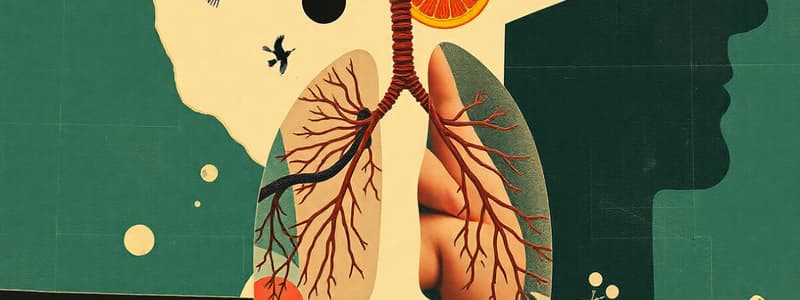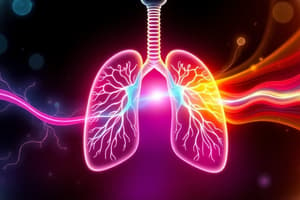Podcast
Questions and Answers
What role do tracheoles play in the respiratory system of insects?
What role do tracheoles play in the respiratory system of insects?
- Act as lungs for breathing
- Transport oxygen through the circulatory system
- Filter out pollutants from the air
- Increase surface area for gas exchange (correct)
Which statement is true regarding amphibian respiration?
Which statement is true regarding amphibian respiration?
- All adult amphibians breathe exclusively through gills
- Respiration in amphibians relies solely on their circulatory system
- Only adult amphibians possess lungs
- Some salamanders breathe only through their skin (correct)
What characterizes the respiratory system of birds?
What characterizes the respiratory system of birds?
- Air flows in a tidal manner into and out of the lungs
- Air sacs are not involved in respiration
- Lungs undergo significant volume changes
- Gas exchange occurs using a cross-current system (correct)
What is the approximate thickness of the barrier between blood and air in mammalian lungs?
What is the approximate thickness of the barrier between blood and air in mammalian lungs?
What respiratory mechanism is employed by air-breathing fish and amphibians?
What respiratory mechanism is employed by air-breathing fish and amphibians?
Why are respiratory pigments necessary?
Why are respiratory pigments necessary?
Which of the following describes tidal volume in mammals?
Which of the following describes tidal volume in mammals?
What is a common feature of the lungs of mammals?
What is a common feature of the lungs of mammals?
What is the primary mechanism by which flatworms obtain oxygen?
What is the primary mechanism by which flatworms obtain oxygen?
What structure represents an evaginated respiratory organ?
What structure represents an evaginated respiratory organ?
Which term is used to describe the respiratory organs in fish?
Which term is used to describe the respiratory organs in fish?
How do fish effectively increase oxygen extraction from water?
How do fish effectively increase oxygen extraction from water?
What role do air sacs play in the insect respiratory system?
What role do air sacs play in the insect respiratory system?
What is the function of spiracles in insects?
What is the function of spiracles in insects?
Which organ type is not typically involved in mammalian respiratory systems?
Which organ type is not typically involved in mammalian respiratory systems?
What is the importance of the lamellae in fish gills?
What is the importance of the lamellae in fish gills?
What distinguishes lungs from gills as respiratory organs?
What distinguishes lungs from gills as respiratory organs?
Which feature is essential for the function of tracheae in insects?
Which feature is essential for the function of tracheae in insects?
What is the primary function of respiration in organisms?
What is the primary function of respiration in organisms?
How do protozoa like Amoeba and Paramecium exchange gases?
How do protozoa like Amoeba and Paramecium exchange gases?
What energy-carrying molecule is produced during cellular respiration?
What energy-carrying molecule is produced during cellular respiration?
In which level of organization does cellular respiration primarily occur?
In which level of organization does cellular respiration primarily occur?
Which strategy is related to gas exchange in different groups of organisms?
Which strategy is related to gas exchange in different groups of organisms?
Flashcards
Gas exchange
Gas exchange
The process that supplies oxygen for cellular respiration and disposes of carbon dioxide.
Cellular respiration
Cellular respiration
A set of metabolic reactions and processes that take place in cells to convert biochemical energy from nutrients into ATP (chemical energy) and release waste products.
Respiratory medium
Respiratory medium
The medium, either air or water, that surrounds an organism and contains the necessary gases for respiration.
Respiratory surface
Respiratory surface
Signup and view all the flashcards
Gas exchange in Protozoa
Gas exchange in Protozoa
Signup and view all the flashcards
Diffusion
Diffusion
Signup and view all the flashcards
Invaginations and Evaginations
Invaginations and Evaginations
Signup and view all the flashcards
External Gills
External Gills
Signup and view all the flashcards
Lungs
Lungs
Signup and view all the flashcards
Internal Gills
Internal Gills
Signup and view all the flashcards
Branchial
Branchial
Signup and view all the flashcards
Pulmonary
Pulmonary
Signup and view all the flashcards
Tracheae
Tracheae
Signup and view all the flashcards
Spiracles
Spiracles
Signup and view all the flashcards
Tracheoles
Tracheoles
Signup and view all the flashcards
Tracheal Respiration
Tracheal Respiration
Signup and view all the flashcards
Amphibian Respiration
Amphibian Respiration
Signup and view all the flashcards
Bird Respiration
Bird Respiration
Signup and view all the flashcards
Mammalian Lungs
Mammalian Lungs
Signup and view all the flashcards
Thin Respiratory Membrane
Thin Respiratory Membrane
Signup and view all the flashcards
Air Movement
Air Movement
Signup and view all the flashcards
Respiratory Pigments
Respiratory Pigments
Signup and view all the flashcards
Study Notes
Respiration - BL1004
- Cellular respiration is a set of metabolic reactions and processes that take place in the cells of organisms to convert biochemical energy from nutrients into ATP (chemical energy)
- The process supplies oxygen for cellular respiration and disposes of carbon dioxide.
- Organisms have various methods for gas exchange depending on their environment, including specialized respiratory surfaces.
Gas Exchange
- Gas exchange involves getting oxygen (O2) to cells and removing carbon dioxide (CO2).
- Respiratory surfaces can be found in flatworms, fish, terrestrial arthropods, mammals and Protozoa.
- Different organisms use different strategies for gas exchange depending on the environment
- Single-celled organisms (e.g., Amoeba, Paramecium) exchange gases across the plasma membrane by simple diffusion.
- Small invertebrates, like flatworms, exchange gases efficiently across their thin body walls due to their size.
- In flatworms, diffusion is adequate for the animal's needs.
Respiratory Systems
- Specialized respiratory organs increase the surface area for gas exchange in organisms with complex structures.
- Specialized respiratory organs like gills are evaginated structures, while lungs are invaginated structures.
- Types of respiratory organs include: lungs, external gills, and internal gills.
- Descriptive terms for these include: branchial for gills, and pulmonary for lungs -Examples of organs/ organisms with relevant respiratory systems include external gills, internal gills, and lungs
- Starfish breathe using tube feet and gills known as branchial papulae.
- Counter-current exchange is an efficient mechanism for gas exchange in fish gills. During this process, blood flows in the opposite direction to the water current over the gills.
- Blood and water flow in opposite directions.
- This allows for gas exchange in low oxygen.
- The efficiency of countercurrent exchange can also occur in mammals using lungs.
- Different respiratory organ types are seen in various species to aid their specific needs
Tracheal Systems in Insects
- The tracheal system in insects consists of tiny branching tubes that penetrate the body.
- Air sacs serve as reservoirs for organs
- Air enters the tracheae through spiracles.
- Tracheoles are closed tubes and contain fluid.
- When insects are active, fluid is withdrawn to increase the surface area for gas exchange.
- Bellow-like movements are used by larger insects to pump air into the tracheal system.
- Gas-exchange surface (tracheoles) in insects is close to all body cells.
- Circulatory systems play a smaller role in insect respiration.
Amphibians
- Larval amphibians often have gills and use their skin for gas exchange.
- Most adult amphibians use lungs and skin for respiration.
- Some adult amphibians, like mudpuppies (Necturus) and axolotl, retain gills.
- Some salamanders breathe only through highly vascularized skin that needs lots of blood vessels.
- Some frogs hibernate in water and use their skin for breathing.
Birds
- Bird lungs are rigid and do not change volume much during breathing.
- Air sacs expand and contract for breathing.
- Air flows unidirectionally through the bird's gas exchange system.
- This is a crucial component of the bird´s cross-current system
- Air sacs are crucial for efficient oxygen uptake
Mammals - Lungs
- Mammalian lungs have many branching airways (bronchi) and millions of alveoli.
- Alveoli provide a large surface area for gas exchange, proportionate to size.
- The gas exchange surface area of human lungs is equivalent to the surface area of a tennis court
- The barrier between blood and air in mammalian lungs is only two cell layers thick.
- Blood vessels and alveoli are closely interconnected in mammalian lungs
Movement of Air
- Buccal pressure is used for air-breathing in fish and amphibians.
- Suction/ aspiration is used in reptiles, mammals, and birds for breathing.
- Mammals and birds use thoracic and abdominal muscles during breathing.
- Tidal volume in humans is approximately 500 mL.
- Vital capacity in humans is 3.4 to 4.8 liters.
- Residual volume in humans is approximately 1.5 liters
Respiratory Pigments
- Respiratory pigments are required to bind and transport gases.
- O2 has low solubility in water; pigments help overcome this.
- Hemoglobin (Fe) is the respiratory pigment in almost all vertebrates.
- It's in red blood cells.
- Hemocyanin (Cu) is a respiratory pigment found in arthropods and most mollusks.
Oxygen Transport
- Hemoglobin reversibly binds and releases oxygen (O2) according to the partial pressure of oxygen (PO2)
- Loading/ unloading of oxygen happens in the lungs and tissues respectively.
Studying That Suits You
Use AI to generate personalized quizzes and flashcards to suit your learning preferences.




